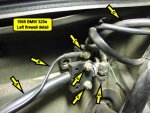Hi,
I've got a 1985 - 325e. I'm thinking about upgrading to
CIBIE headlights. This might also require adding
additional heavier wiring, relays and fuses.
When looking at the existing wiring, I can see a big +12
volt wire coming from the battery in the trunk up into the engine
compartment. There it attaches to a "terminal" on the left
side of the firewall. I'm trying to identify the details of
that "terminal". Please see the attached photo.
Two questions:
1) Points C and D measure +12 VDC as expected, but why don't
points E and F also? What is their purpose?
2) A is the big +12 wire coming from the battery, but there is also
a smaller wire at B that seems to simply run in parallel to the main
+12 wire. What is the smaller wire? Why run this separate additional
wire right next to the main +12 wire? Why isn't all the current
just pulled through the one big wire?
Thanks,
Alan Cobb
I've got a 1985 - 325e. I'm thinking about upgrading to
CIBIE headlights. This might also require adding
additional heavier wiring, relays and fuses.
When looking at the existing wiring, I can see a big +12
volt wire coming from the battery in the trunk up into the engine
compartment. There it attaches to a "terminal" on the left
side of the firewall. I'm trying to identify the details of
that "terminal". Please see the attached photo.
Two questions:
1) Points C and D measure +12 VDC as expected, but why don't
points E and F also? What is their purpose?
2) A is the big +12 wire coming from the battery, but there is also
a smaller wire at B that seems to simply run in parallel to the main
+12 wire. What is the smaller wire? Why run this separate additional
wire right next to the main +12 wire? Why isn't all the current
just pulled through the one big wire?
Thanks,
Alan Cobb
Attachments
-
47.9 KB Views: 154


![Big Grin [:D] [:D]](/images/smilies/biggrin.png) ).
).